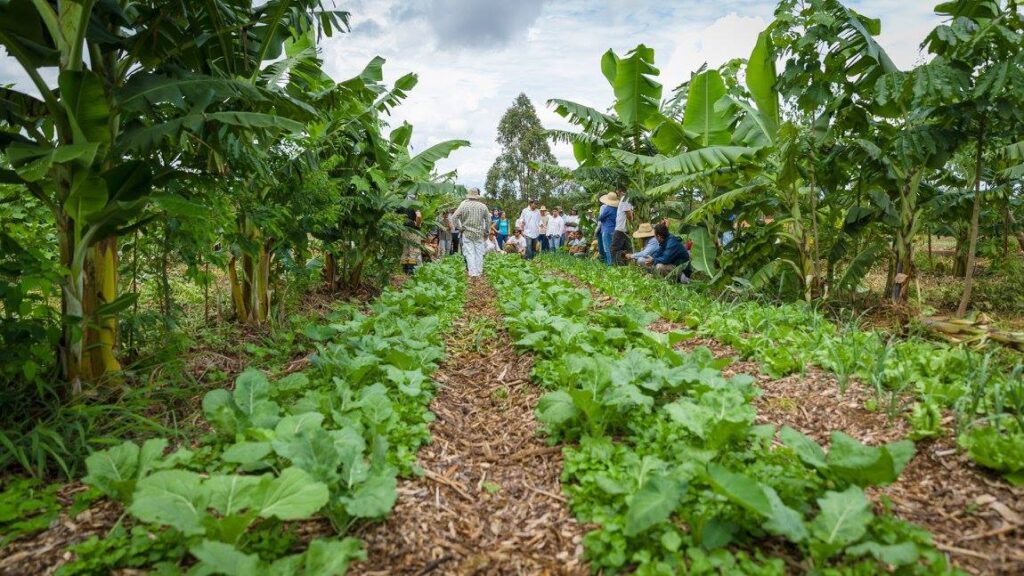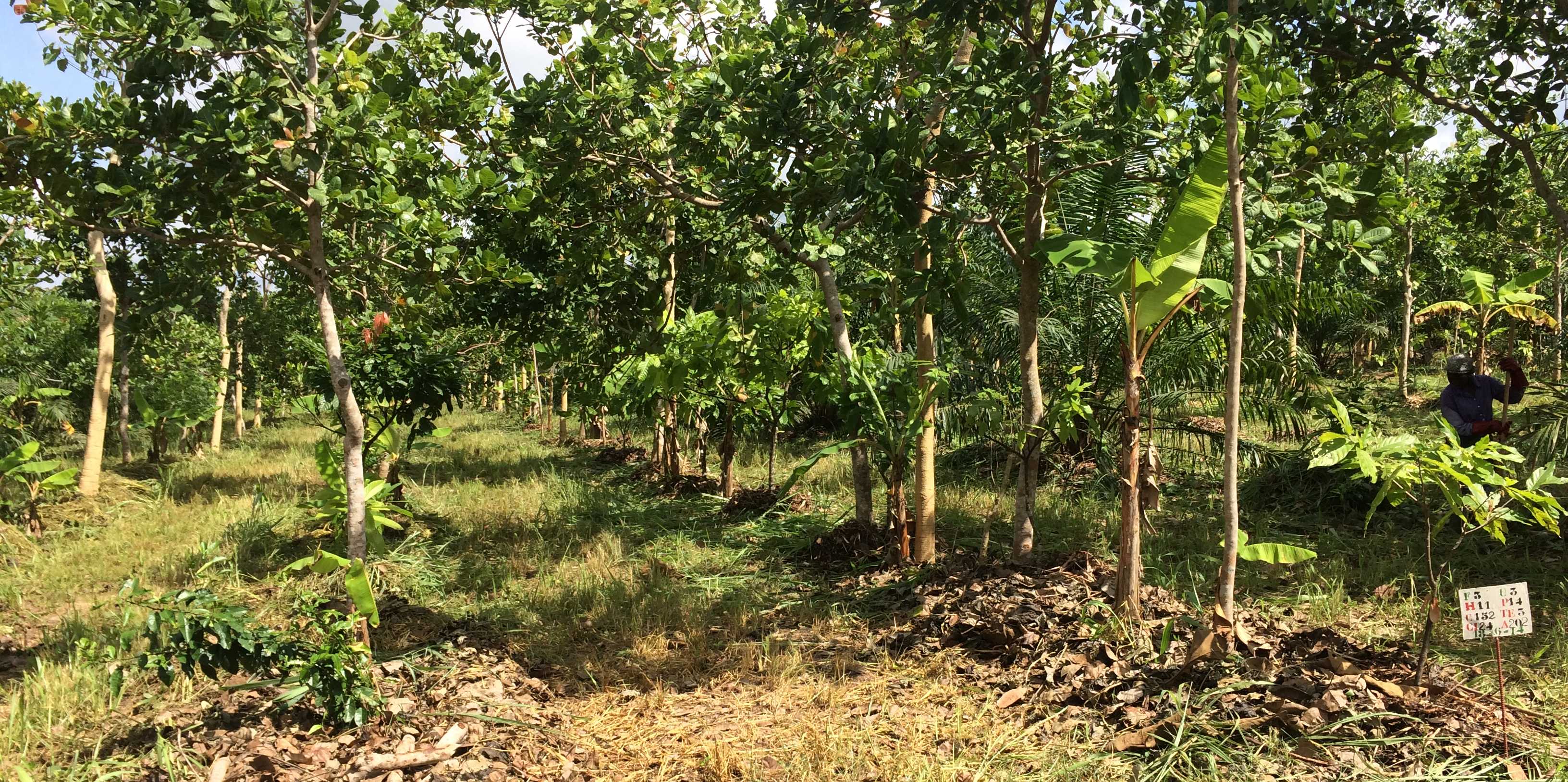Wheat is a staple crop that requires specific soil management and fertilization practices to achieve ...
Agroforestry is a term derived from two words: "Agriculture" and "Forestry." It is a land-use system in which trees are cultivated in a well-planned manner. This system includes the production of timber trees or shrub-like plants/bamboo along with food crops, fodder production combined with animal husbandry, fish farming, beekeeping, sericulture (silk farming), or lac production, etc.
कृषि वानिकी 2 शब्दों “कृषि” व “वानिकी” के मिलने से बना है | अर्थात कृषि वानिकी भूमि उपयोग की वह प्रणाली है, जिसमें सुनियोजित ढंग से वृक्षों की खेती की जाती है | इसके अंतर्गत काष्ठ वृक्ष या झाड़ीदार पौधों / बांस के साथ खाद्यान्न फसलों का उत्पादन, चारा उत्पादन के साथ पशुपालन, मछलीपालन, मधुमक्खीपालन, रेशम कीट पालन या लाह उत्पादन इत्यादि को अपनाया जाता है।इस लेख में हम कृषि वानिकी के महत्व, इसकी विभिन्न पद्धतियों और इससे जुड़ी चुनौतियों पर विस्तार से चर्चा करेंगे।
1.) कृषि वानिकी में भूमि का सुनियोजित एवं वैज्ञानिक उपयोग किया जाता है । इसका लाभ यह है कि भूमि से अनुकूलतम लाभ की प्राप्ति होती है |
2.) दैनिक जीवन में उपयोग के लिए काष्ठ -लकड़ी, पशुओं के लिए चारा ,जलावन आदि की प्राप्ति कृषि वानिकी से होती है तथा साथ ही प्राकृतिक वनों से इसका दोहन कम होता है।
3.) कृषि वानिकी भूमिगत जल के स्तर को बढ़ाने में सहायक होता है।
4.) मृदा संरक्षण का वास्तविक अर्थ केवल मृदा को ह्रास से बचाना नहीं ,बल्कि उसकी गुणवत्ता को भी बनाए रखना है |

1.) कृषि वानिकी भी कई प्रकृति की हो सकती है | सर्वाधिक आम पद्धति में फसलों के साथ वन- वृक्षों को खेतों में उगाया जाता है। वृक्ष या तो मुख्य खेत में कतारों या खेतों के मेढ़ों पर उगाये जा सकते हैं ताकि वे एक अवरोध (fencing) के तौर पर काम करें |
2.) दूसरी पद्धति वन चारागाह की है | इस पद्धति के अंतर्गत वृक्षों के मध्य चारा घास उगाते हैं, जैसे- नेपियर या स्थानीय घास। कई बार वृक्ष भी चारे के रूप में काम आते हैं | इस प्रकार कृषि वानिकी के साथ पशुपालन को सुगमता से किया जा सकता है |
3.) एक अन्य पद्धति में फलदार वृक्षों, जैसे – आम, लीची, अमरूद, बेर, आंवला इत्यादि के साथ वानिकी वृक्ष शीशम, बबूल तथा विभिन्न प्रकार की खाद्यान्न फसलें एक साथ उगायी जाती हैं ।
4.) उद्यान पद्धति में पहले वन -पौधे लगा दिये जाते हैं और उपल्ब्ध स्थान में छोटे फलदार वृक्ष लगा दिये जाते हैं जैसे -नीबू, केला, पपीता, अनन्नास, स्ट्रोबेरी आदि |
5.) वनवर्द्धन जल पद्धति : इस पद्धति को जल- वानिकी भी कहते हैं। इस पद्धति में तालाबों के चारों तरफ वन- पौधे लगा दिये जाते हैं जिनकी पत्तियां व फल तालाब में गिरते हैं |

भारत में कृषि वानिकी निश्चित रूप से एक अच्छा विकल्प है लेकिन इसे लेकर कुछ समस्याएं भी हमारे सामने हैं | सबसे पहला, जैसा कि हम जानते हैं हमारे देश में अधिकांश किसान लघु व सीमांत किसान हैं, अर्थात उनकी जोत का आकार छोटा है जबकि कृषि वानिकी के लिए अपेक्षाकृत अधिक क्षेत्र की आवश्यकता होती है | दूसरी समस्या जागरूकता को लेकर है | हमारे देश में किसान आम तौर पर पारंपरिक कृषि पद्धति को ही अपनाते आए हैं और वे कृषि वानिकी के लाभ से कुछ हद तक अनभिज्ञ हैं | आवश्यकता है इस क्षेत्र में जागरूकता फैलाने के लिए कार्य करने की | इसके तहत सरकार द्वारा वित्तीय सहायता भी उपलब्ध कराई जा सकती है और तकनीकों व प्रशिक्षण को कृषकों तक पहुंचाया जा सकता है |
कृषि वानिकी एक प्रभावी भूमि उपयोग प्रणाली है, जिसमें कृषि और वानिकी को एक साथ जोड़ा जाता है। इससे न केवल भूमि का वैज्ञानिक और सुनियोजित उपयोग होता है, बल्कि काष्ठ, चारा, जलावन, खाद्यान्न, पशुपालन, मछलीपालन और मधुमक्खीपालन जैसी अनेक गतिविधियों को भी बढ़ावा मिलता है। यह मृदा संरक्षण और जल स्तर वृद्धि में सहायक होता है। इस क्षेत्र में सरकारी सहयोग, वित्तीय सहायता और तकनीकी प्रशिक्षण द्वारा किसानों को प्रेरित किया जा सकता है, जिससे कृषि वानिकी को अधिक लोकप्रिय और व्यावहारिक बनाया जा सके।
कृषि से संबंधित वीडियो देखने के लिए यहाँ क्लिक करें: YouTube
1.) In agroforestry, land is utilized in a planned and scientific manner. The benefit of this is that optimal benefits can be obtained from the land.
2.) Agroforestry provides timber for daily use, fodder for animals, and firewood, thereby reducing dependence on natural forests.
3. ) Agroforestry helps in increasing the groundwater level.
4. ) The true meaning of soil conservation is not just to prevent soil degradation but also to maintain its quality.
1.) Agroforestry can take various forms. The most common method involves growing forest trees alongside crops in fields. These trees can be planted in rows within the main field or along field boundaries to serve as a barrier (fencing).
2.) Clavipectoral System: This method involves growing fodder grasses, such as Napier grass or local grass species, between trees. In some cases, trees themselves serve as fodder. This approach allows for the integration of agroforestry with livestock farming.
3. ) Agri-Horticultural System: This method includes growing fruit-bearing trees like mango, litchi, guava, ber, and amla along with forestry trees such as Sheesham, Acacia, and various food crops.
4.) Horticultural System: In this approach, forest plants are planted first, and smaller fruit-bearing trees such as lemon, banana, papaya, pineapple, and strawberries are grown in the available space.
5.) Aqua-Forestry System: Also known as water-based forestry, this method involves planting trees around ponds. The leaves and fruits of these trees fall into the pond, benefiting aquatic life.
Agroforestry is undoubtedly a good option in India, but it also comes with certain challenges. The first major issue is landholding size. As we know, the majority of farmers in India are small and marginal farmers, meaning their landholdings are small, whereas agroforestry requires relatively larger areas. The second issue is lack of awareness. Farmers in India generally follow traditional agricultural practices and are somewhat unaware of the benefits of agroforestry. There is a need to work on spreading awareness in this sector. To address these challenges, the government can provide financial assistance and ensure that modern techniques and training programs reach farmers effectively.
Agroforestry is an effective land-use system that integrates agriculture and forestry. It ensures the scientific and planned utilization of land while promoting various activities such as timber production, fodder, firewood, crop cultivation, livestock farming, fish farming, and beekeeping. It also plays a significant role in soil conservation and groundwater recharge. With government support, financial assistance, and technical training, farmers can be encouraged to adopt agroforestry, making it more popular and practical.
0
0
Wheat is a staple crop that requires specific soil management and fertilization practices to achieve ...
भारत में कृषि न केवल एक प्रमुख आर्थिक � ...
Neem cake is an organic byproduct derived from cold-pressed neem seeds after the extraction of neem ...
खरीफ फसलें-मानसून के मौसम में उगाई जात ...
Rice farming requires careful management of soil nutrients to ensure optimal growth and yield. The a ...
Fertilizers are essential substances used in agriculture to enhance the growth and productivity of c ...
Mango farming is a significant agricultural practice in many tropical and subtropical regions. Known ...
Organic farming is an agricultural practice that focuses on growing crops and raising livestock in a ...
Crop rotation, a key agricultural practice, involves growing different crops in the same field acros ...
Soil fertility is crucial for any farmer or gardening enthusiast. Fertile soil promotes healthy plan ...
Soil testing is a process that provides farmers with crucial information about the quality, nutrient ...
The tradition of farming in India is centuries old, and wheat and barley hold significant importance ...
The Aak plant (Calotropis gigantea) is a remarkable creation of nature, valued for its distinctive f ...
Roses, known for their beauty and enchanting fragrance, are the pride of every garden. However, main ...
Agricultural Pollution refers to the harmful effects caused by agricultural activities on the enviro ...
Temperature fluctuations have a direct impact on wheat farming. It affects sowing, growth, grain for ...
During summer, rising temperatures increase the risk of fire in wheat crops. As April begins, wheat ...
कृषि में आर्टिफिशियल इंटेलिजेंस (AI) क ...
Contour Farming is a very common farming technique practiced in India. It is commonly practiced in h ...
Vegetables to Sow in May : Dear farmer friends, in the month of May, our plants don't usually suff ...
Papaya is a highly nutritious fruit loaded with medicinal properties. Its consumption helps regula ...
India is an agrarian country with three major agricultural seasons and a variety of crops being prod ...
Leaf curl disease, which causes leaves to curl, is a serious threat to agriculture. This disease aff ...
Intercropping is a farming method where two or more crops are grown together in the same field. It h ...
Mulching is a layer spread over the surface of the soil, primarily aimed at retaining soil moistur ...
India is an agriculture-based country, yet many farmers can’t use their land as it remains barren ...